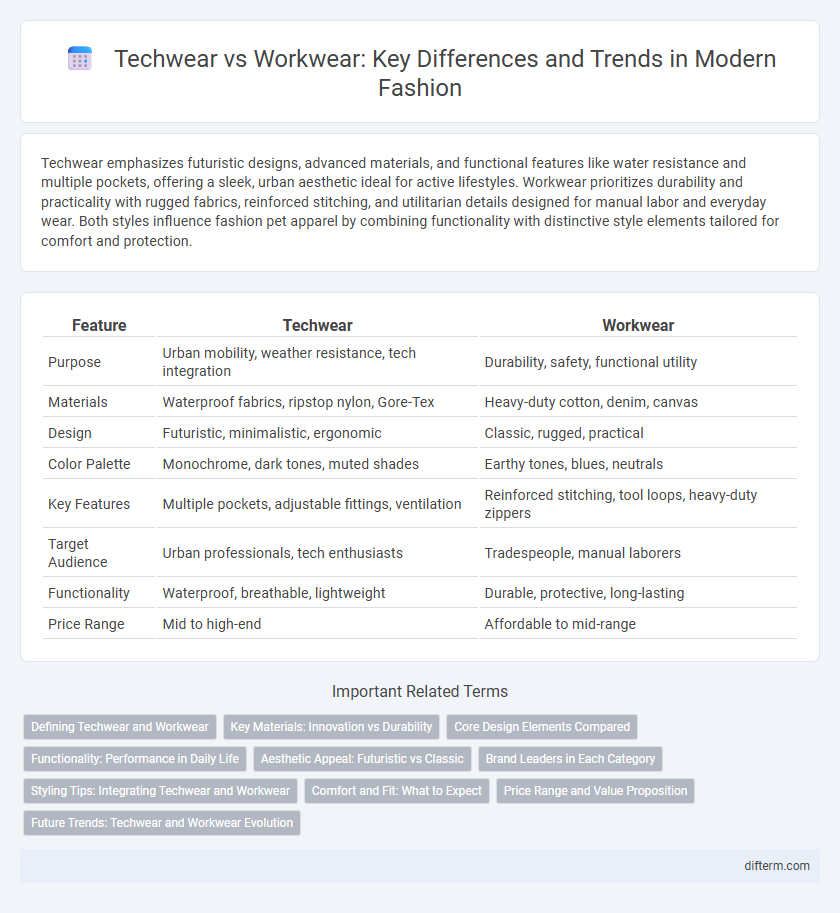Techwear emphasizes futuristic designs, advanced materials, and functional features like water resistance and multiple pockets, offering a sleek, urban aesthetic ideal for active lifestyles. Workwear prioritizes durability and practicality with rugged fabrics, reinforced stitching, and utilitarian details designed for manual labor and everyday wear. Both styles influence fashion pet apparel by combining functionality with distinctive style elements tailored for comfort and protection.
Table of Comparison
| Feature | Techwear | Workwear |
|---|---|---|
| Purpose | Urban mobility, weather resistance, tech integration | Durability, safety, functional utility |
| Materials | Waterproof fabrics, ripstop nylon, Gore-Tex | Heavy-duty cotton, denim, canvas |
| Design | Futuristic, minimalistic, ergonomic | Classic, rugged, practical |
| Color Palette | Monochrome, dark tones, muted shades | Earthy tones, blues, neutrals |
| Key Features | Multiple pockets, adjustable fittings, ventilation | Reinforced stitching, tool loops, heavy-duty zippers |
| Target Audience | Urban professionals, tech enthusiasts | Tradespeople, manual laborers |
| Functionality | Waterproof, breathable, lightweight | Durable, protective, long-lasting |
| Price Range | Mid to high-end | Affordable to mid-range |
Defining Techwear and Workwear
Techwear emphasizes futuristic design, advanced materials, and functional features such as waterproof fabrics, breathable membranes, and modular components, catering to urban mobility and adaptability. Workwear prioritizes durability, comfort, and utility with reinforced stitching, heavy-duty fabrics like canvas or denim, and practical elements such as tool pockets and reinforced knees, designed for manual labor and industrial environments. Both styles merge functionality with aesthetics but differ in their core purposes and technological integration.
Key Materials: Innovation vs Durability
Techwear utilizes advanced synthetic fabrics like Gore-Tex and Dyneema, prioritizing innovation with waterproof, breathable, and lightweight properties for enhanced functionality. Workwear relies on traditional materials such as heavy-duty cotton canvas and reinforced denim, emphasizing durability and resistance to wear and tear under harsh conditions. The contrasting fabric choices highlight techwear's focus on cutting-edge performance technology versus workwear's emphasis on rugged, long-lasting construction.
Core Design Elements Compared
Techwear emphasizes functionality with weather-resistant fabrics, modular components, and ergonomic cuts designed for urban mobility. Workwear prioritizes durability using heavyweight cotton, reinforced seams, and practical pockets suited for manual labor environments. Both styles integrate utility, but techwear leans toward futuristic aesthetics while workwear maintains traditional ruggedness.
Functionality: Performance in Daily Life
Techwear excels in functionality by integrating advanced fabrics like Gore-Tex and TPU coatings, offering superior water resistance, breathability, and durability for urban environments. Workwear emphasizes heavy-duty materials such as canvas and denim, prioritizing rugged construction and reinforced stitching to withstand physical labor and harsh conditions. Both styles enhance daily performance but target different needs: techwear suits dynamic city life with innovative features, while workwear ensures protection and comfort in manual, industrial tasks.
Aesthetic Appeal: Futuristic vs Classic
Techwear emphasizes a futuristic aesthetic with sleek lines, innovative materials, and a utilitarian, urban edge designed for modern functionality. Workwear embodies a classic aesthetic characterized by durable fabrics, timeless silhouettes, and a rugged, practical appeal rooted in traditional craftsmanship. The contrast highlights techwear's cutting-edge design ethos against workwear's enduring, heritage-inspired style.
Brand Leaders in Each Category
Acronym, known for its cutting-edge techwear designs, integrates advanced fabrics and urban functionality to lead the market with futuristic aesthetics. Carhartt WIP dominates the workwear segment by blending durability and heritage craftsmanship, catering to both industrial use and streetwear culture. These brands exemplify innovation and authenticity, shaping the distinct identities of techwear and workwear in contemporary fashion.
Styling Tips: Integrating Techwear and Workwear
Styling techwear and workwear involves balancing functionality with urban aesthetics by pairing techwear's waterproof shells and ergonomic designs with workwear's sturdy fabrics and utilitarian details. Incorporate layering techniques using cargo pants, utility vests, and technical outerwear to create a versatile look suitable for both city streets and rugged environments. Opt for monochromatic color schemes and performance materials to maintain a cohesive, practical outfit that emphasizes durability and modern style.
Comfort and Fit: What to Expect
Techwear prioritizes ergonomic design with flexible, breathable fabrics that adapt to various weather conditions, ensuring maximum comfort during dynamic movement. Workwear emphasizes durability and protective features, often resulting in a heavier fit, but modern iterations incorporate stretch materials to improve mobility and wearer comfort. Expect techwear to offer a slimmer, tailored fit optimized for urban environments, while workwear provides a looser, more utilitarian fit for physical labor.
Price Range and Value Proposition
Techwear typically ranges from $150 to $600 per item, emphasizing advanced materials like Gore-Tex for waterproofing and breathability, offering high functionality and futuristic aesthetics. Workwear is generally more affordable, priced between $50 and $200, prioritizing durability and practicality with heavy-duty fabrics such as canvas and denim designed for physical labor. The value proposition in techwear lies in innovative design and performance enhancement, while workwear focuses on cost-effectiveness and robust wear resistance suitable for demanding environments.
Future Trends: Techwear and Workwear Evolution
Techwear and workwear are increasingly integrating smart fabrics and functional design, driving the evolution of both styles toward enhanced durability and adaptability. Innovations like moisture-wicking textiles, reinforced stitching, and modular components are setting future trends, blending utility with urban aesthetics. The fusion of techwear's futuristic features and workwear's rugged practicality signals a shift towards versatile, performance-oriented fashion.
techwear vs workwear Infographic

 difterm.com
difterm.com